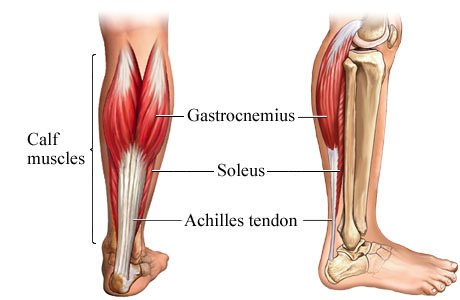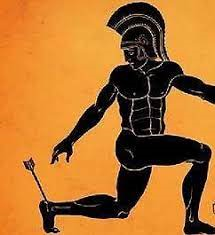Know your Injuries – Part 3: Achilles Tendonitis
Dr Meenakshi presents her Sports Injury Management Series – Part 3: Achilles tendonitis

Dr Meenakshi (P. T.) explains how we can help the Achilles tendon – also referred to as the calcaneal tendon – to safely and swiftly recover from injury so that we minimize the risk of its reoccurrence. She breaks down her explanation in terms of –
- symptoms,
- causes,
- prevention,
- first aid,
- basic rehab movements
Achilles tendinitis or tendonitis is an overuse injury of the Achilles tendon – the strong band of tissue that connects the gastrocnemius and soleus muscles of the calf into the heel bone. The contracting calf muscles lift the heel by this tendon, thus producing a foot action that is essential to walking, running and jumping – in fact: to all movements generating from the lower body. It is the thickest and most powerful tendon in the body.

The Achilles Tendon was so named (in 1693) after the Greek hero Achilles, the ancient Greek mythological figure. In Greek mythology, he was the greatest of all the Greek warriors and the central character of Homer’s Iliad. Legends state that Achilles was invulnerable in all of his body except for one heel, because when his mother Thetis dipped him in the river Styx as an infant, she held him by one of his heels. It is in this context The term “Achilles’ heel” has come to mean a point of weakness, especially in someone or something with an otherwise strong constitution. The Achilles tendon is also named after him due to these legends.
Symptoms
It is is vulnerable to tendonitis (inflammation or irritation of a tendon), tear, and rupture. Microtears caused by acute injury or by chronic strain due to repetitive trauma produce pain and swelling. If it is completely torn or ruptured, the use of the leg for running and jumping is lost for prolonged a period. Tendon ruptures often need surgery and immobilization of the ankle for weeks or months.
- Stiffness and pain.
- Limited range of motion of the ankle
- A “crackling” sound or crepitation when the tendon is moved
- Redness over the inflamed portion of the tendon
Causes
- Achilles tendinitis commonly occurs in runners who have suddenly increased the intensity or duration of their runs. It is also common in middle-aged “weekend warriors” – people who play sports like tennis or basketball only on the weekends. The risk of injury is higher in case of contact sports that necessitate sprint starts, kicking and jumping.
- Strain from overuse of the lower leg muscle and ankle joint.
- Partial tearing of the tendon.
- Direct injury to the lower leg, foot or ankle – tendinitis is more likely where the injury is repeated.
Infection of tissue through broken skin at the time of injury.
Prevention
- It is essential to engage in a physical conditioning that involves appropriate strength and flexibility building movements prior to playing sports.
- Stretch the calf muscles as also the tendon prior to physical activity.
- Improve functional movement and dynamic balance.
- Improve technique of sports movement or exercise like “calf raises” with external resistance in the weight training studio.
First Aid
There is no specific first aid in this context as the injury develop over a period of time. At the sign of the very first symptom, stop the activity and rest! As pain and swelling to appear, ice the injured area. Compress injury by gently wrapping with an elastic bandage. Elevate injured area above the heart level, if possible.
Management will follow P.R.I.C.E. drill –
- Protect the injured part, not allowing any further damage.
- Rest the injured part.
- Apply ice or cold treatment for 15-20 minutes.
- Compression: use of mild to moderate pressure to the injured area with bandages / crepe bandages is advisable.
Current international standards have replaced P.R.I.C.E. with P.O.L.I.C.E.
- P – Protection of injured part
- O/L – Application of Optimal load (local injury factors) / Training load
- C.E. – as mentioned earlier (ice + compression+ elevation)
Specialized braces from your physio may also be used to provide compression. This may be followed up with wrapping the ankle area with crepe or elasticized bandage until healing is complete. The physio may even recommend “heel lifts” in the shoes. Heat therapy in the form of infra-red heat lamps, hot soaks or fomentation, etc., may also be recommended.
Nutrition plays a big role in the recovery process and the injured person must consult a certified sports nutritionist. Scientific evidence suggests proteins, amino acids (leucine, arginine, glutamine), vitamins C and D, manganese, copper, zinc, and phytochemicals may be useful in improving tendon growth and healing.
Exercises to prevent and strengthen the Achilles Tendon
Dr Meenakshi explains how we can help the Achilles tendon to safely and swiftly recover from injury so that we minimize the reoccurrence.
Stretching and flexibility exercises are key to helping your tendon heal without shortening and causing long-term pain. Strengthening exercises will help you regain strength you might have lost while the tendon was healing.
- Runner’s stretch
- Toe-to-wall stretch
- Heel drop
To get utmost out of each stretch, keep points in mind:
- Take your time. Move slowly, whether you’re deepening into a stretch or changing positions. This will limit the risk of injury and discomfort.
- Avoid bouncing. Quick, sudden movements will only worsen Achilles tendon issues. Stay relaxed during each stretch.
- Keep your heel down. During a calf stretch, plant your heel on the ground. If you lift your heel, the Achilles tendon won’t stretch properly.
- Stretch until you feel minor discomfort, then relax. If you feel sharp pain, stop stretching immediately. Stretching and flexibility exercises are key to helping your tendon heal without shortening and causing long-term pain.
- Stop if you feel pain.
Strengthening exercises will help you regain strength you might have lost while the tendon was healing.
